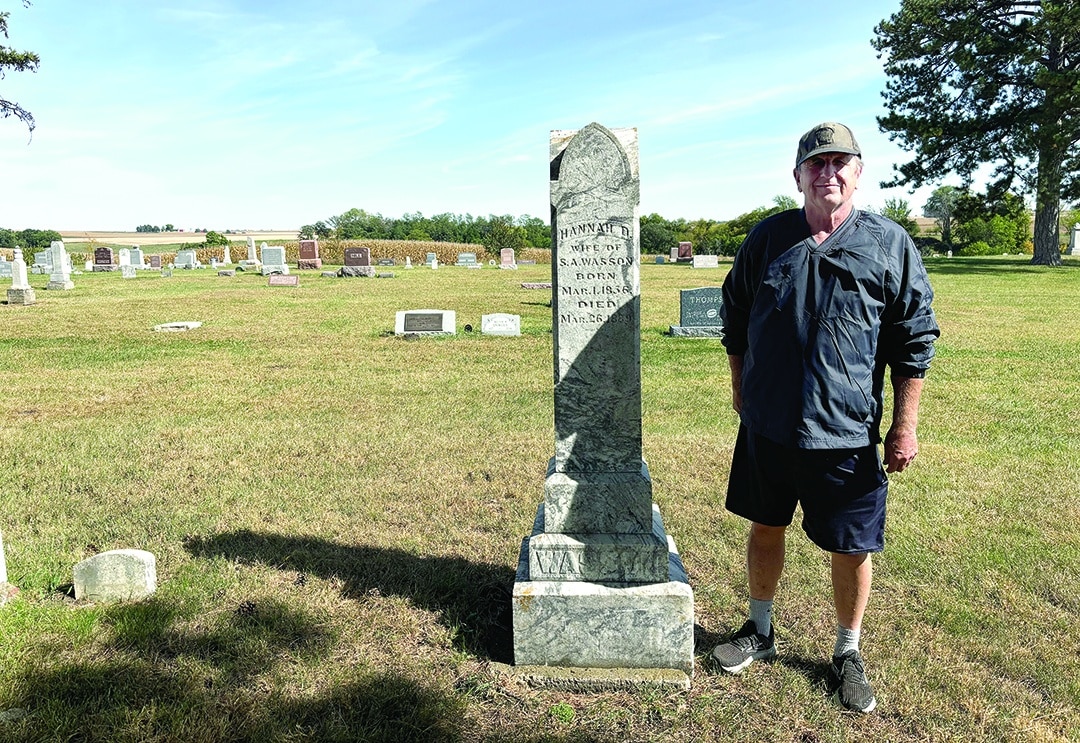
Rod Stanley shows a headstone he helped restore.
Guthrie County has 38 graveyards with 10 identified as “pioneer cemeteries.”
By Rich Wicks | Panora Times
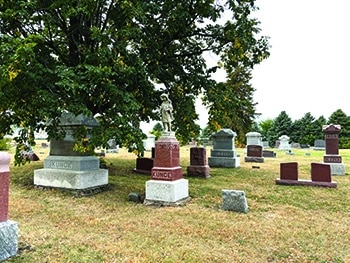
Nineteen people with the last name of Kunce are buried at the Yale Cemetery.
Cemetery etiquette includes several general rules. Cemetery signage (such as visiting hours, speed limits, parking, etc.) should be heeded. Pets, loud activities and horseplay are generally discouraged. Visitors should avoid walking over the top of gravesites, as this can be seen as disrespectful. In a nutshell, be solemn and respectful, especially when other visitors may see or overhear.
Cemeteries in America
In America, we take for granted that we can go visit gravestones of our dearly departed, even decades after the person’s death. It can be comforting to return to the same plot year after year to pay respects. It is also a way to connect younger generations with their ancestors.
But this isn’t true around the globe. Because America is a relatively young country, and a very large country, we have the luxury of large amounts of space to bury our loved ones. But in Europe and some other parts of the world, burials are handled much differently.
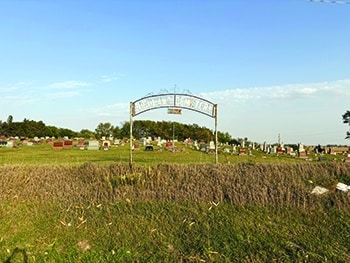
Richland Cemetery is located near Highways 141 and 4.
In America, cemeteries are much newer, especially west of the Appalachian Mountains. But, even in Guthrie County, the number of burial sites/memorials is staggering. Throughout the cemeteries in the county, more than 26,500 people are buried. To put that in perspective, if you decided to decorate one gravesite per day, year-round, it would take almost 73 years to see them all.
Gravestones can be made from many different materials including granite, marble, sandstone, slate and limestone. Historically, wealthy families would choose more expensive options like marble or granite, while middle to lower-class families would opt for limestone, sandstone and even wood. But, this is no longer the case because materials have become more affordable.
First burials in Guthrie County
The first non-native person to die in what would later become Guthrie County was Mr. McCullough (first name not provided) in August of 1850. He was buried near what would later become Morrisburg (south of Panora). A child, identified only as Infant Osander, was buried near McCullough’s grave in 1851. The Morrisburg cemetery was created at a different spot in 1855, but the McCullough graves were not moved.
Compiling history
One of the leading experts in the history of the local county is Kristine Jorgensen, the museum curator at the Guthrie Country Historical Village in Panora. She also has compiled the most extensive collection of data and photos of the county’s cemeteries. Jorgensen explained how she went about this.
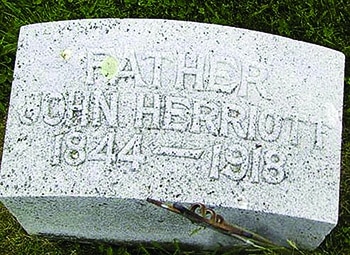
Lieutenant Governor John Herriott is buried in Stuart.
Jorgensen’s booklet is available in the genealogy section at the Jamaica Library. Each page highlights one of Guthrie County’s cemeteries, showing its location on the map. Photos and trivia about the history and/or notable facts on each cemetery are also included.
The cemeteries
When determining how many cemeteries are in Guthrie County, the answer is not immediately clear. Some may have had a new cemetery added nearby, and, in a few cases, both are generally considered to be one. Some cemeteries are no longer active or maintained and may not be publicly accessible. So, an exact count depends on exactly what you are counting.
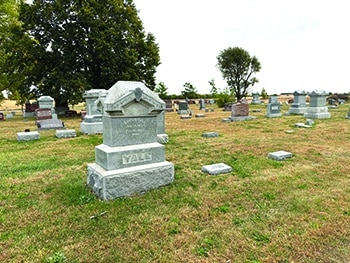
Pictured is the headstone of Byron Yale (1854-1897), son of the founder of Yale.
Morrisburg was a town located a few miles south of Panora. It served as a stop on the Newton stagecoach line. It was also used as part of the Underground Railroad, a network of secret routes and safe houses used by those seeking freedom from slavery in southern states. The Morrisburg cemetery holds many gravesites from before and around the Civil War era.
It’s natural to wonder who may be the most famous or notable person buried in the county. The “Find a Grave” (www.findagrave.com) website, which claims to be the world’s largest gravesite collection with more than 250 million memorials, brings up zero results when searching for “famous” individuals buried in Guthrie County. But North Oak Grove Cemetery offers a possible answer in the name of John Herriott. Herriott was a Civil War veteran who lived from 1844 to 1918 and served as the Guthrie County Treasurer (1878-1882), Iowa State Treasurer (1894-1900) and Lieutenant Governor of Iowa (1902-1907). Despite this, his headstone simply has the word “Father,” his name, and his birth/death years.
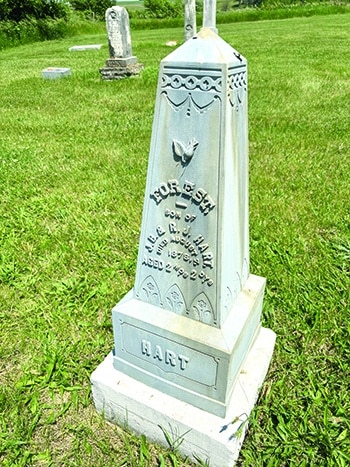
This hollow marker may have been used to hide liquor.
Headstone restoration
Local resident Rod Stanley told of his hobby and passion for restoring and repairing headstones at some of the cemeteries in the county. He explained how he first became interested in doing this.
“I grew up in Dexter, and I have a lot of relatives buried there,” Stanley said. “About 10 years ago, I was visiting markers, and there were so many markers that were broken, unlevel or needed to be set back up, and I decided that I would start doing grave restoration.”
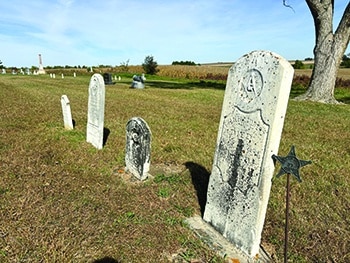
Symbols indicate this grave belongs to a Mason who fought in the Civil War.
“That marker is in West (Cemetery). I’ve done quite a bit of work up there. This particular marker was missing,” Stanley said. “The base was there, but the marker was gone, so I used a probe, and I hit something. It was probably 12 inches underground.”
Stanley dug the marker up, cleaned it, and reattached it to the base.
“A lot of the markers I’ve repaired were in two or three pieces. It was lucky this one was still in one piece. This is the oldest one I’ve found in West Cemetery. Panora was established in 1851, and this marker is from 1851,” Stanley said.
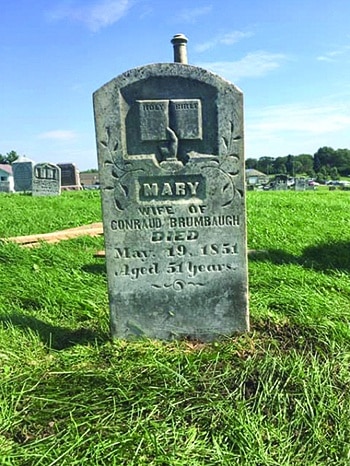
Rod Stanley restored this headstone in West Cemetery in Panora.
Occasionally, local workshops are offered by Stanley and others to teach about the processes and materials involved in headstone cleaning and restoration.
In his time restoring headstones, Stanley learned that during the 1800s, many children died in their first few years of life.
“It was dysentery, cholera, measles, mumps and things that came from unsanitary conditions,” Stanley said.
Costs and options
The cost of an individual burial plot varies by cemetery. Cemeteries generally have a person designated as sexton, who handles the selling and recording of plots. The cost of a plot in Guthrie County is generally $200 or less.
U.S. military veterans, or family members of veterans may receive government financial assistance to buy pay for the expenses of a plot and/or other burial costs. Current details can be obtained by contacting the Veterans Administration.
The list
Below is the list of 38 recognized cemeteries within Guthrie County, along with the approximate location, year each was created, and the number of gravesites, if available. The symbol of * denotes those identified as a pioneer cemetery:
- Bear Grove, southwest part of the county, created in 1875 (508 gravesites)
- Brethren, Panora, 1875 (2,056 gravesites)
- Dalmanutha, Guthrie Center, 1855 (712 gravesites)
- Dodge Center, Bagley, 1879 (1,047 gravesites)
- Glendon, 1871 (373 gravesites)
- Greenwood, unknown (255 gravesites)
- Highland, Bayard, 1879 (1,973 gravesites)
- Immanuel Evangelical Lutheran, Adair, 1890 (548 gravesites)
- Maplewood, Guthrie Center, 1855*
- Menlo, 1880 (860 gravesites)
- Messinger, 1855*
- Moffitt Grove, north of Guthrie Center, 1858 (372 gravesites)
- Monteith, 1882 (487 gravesites)
- Monteith Gravesite, 1961
- Morrisburg, south of Panora, 1855 (1,353 gravesites)
- North Branch, 1886 (54 gravesites)
- North Oak Grove, Stuart, 1856 (3,841 gravesites)
- Orange Township, northwest corner of county, 1888 (922 gravesites)
- Pleasant Hill, North Branch, 1887 (740 gravesites)
- Resurrection, Guthrie Center, 1865 (476 gravesites)
- Richland Memorial, north of Yale, 1876 (1,493 gravesites)
- Rose Hill, Menlo, 1914 (812 gravesites)
- South Oak Grove, Stuart, 1900 (2,725 gravesites)
- Spring Valley, 1864 (121 gravesites)*
- St. John’s Lutheran, 1876
- Stanfield, north of Casey, 1857*
- Sutton, 1874*
- Tuttle’s Grove, northwest corner of county, 1857 (23 gravesites)
- Union, Guthrie Center, 1885 (4,088 gravesites)
- Union, Victory Township, 1,880 (158 gravesites)*
- Valley Township, Guthrie Center, 1857 (723 gravesites)
- Vandevanter, 1853*
- Victory Union Township, north of Guthrie Center, 1892*
- Vanocker, south of Bayard, 1879 (1 gravesite)*
- Van Order, 1860*
- West, Panora, 1851 (1,858 gravesites)
- Wichita, 1880
- Yale, 1887 (485 gravesites)
